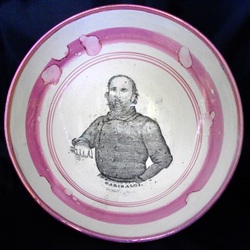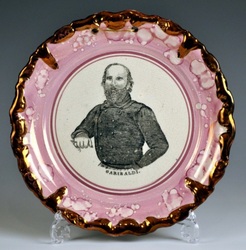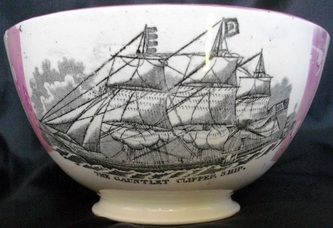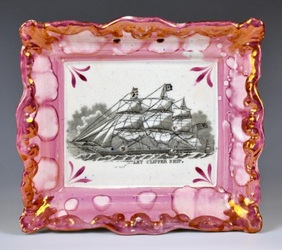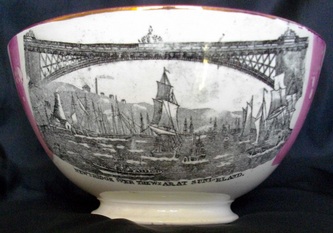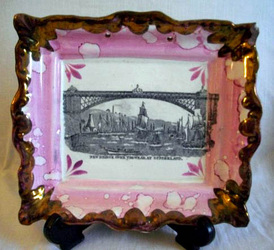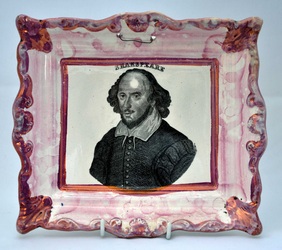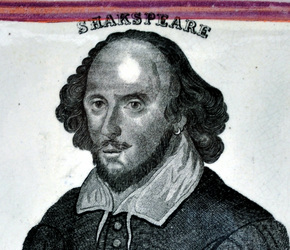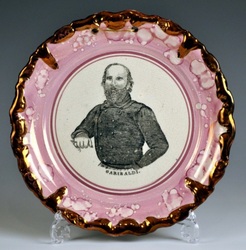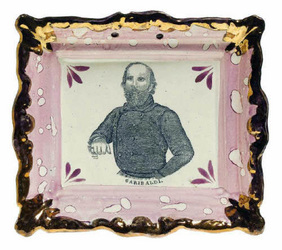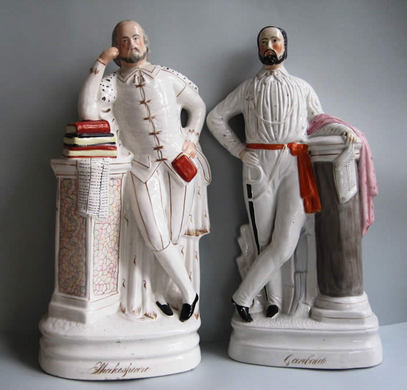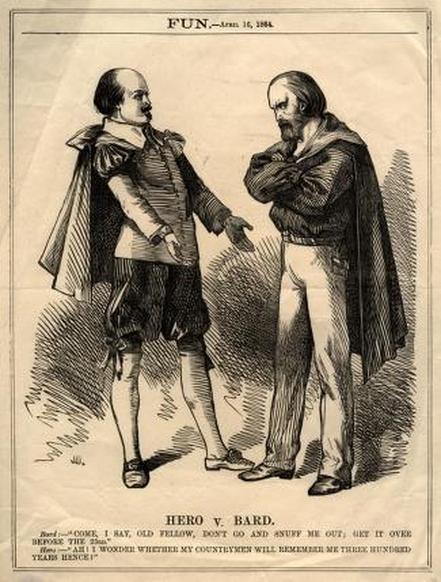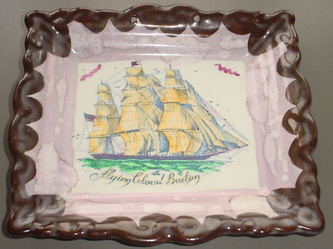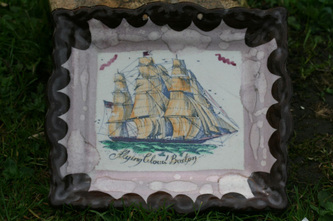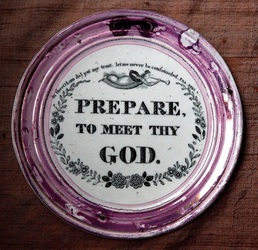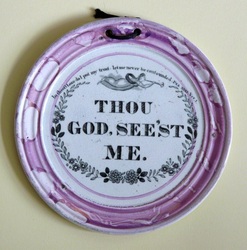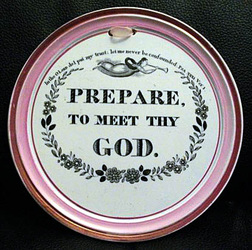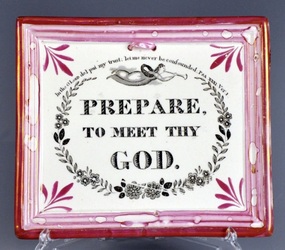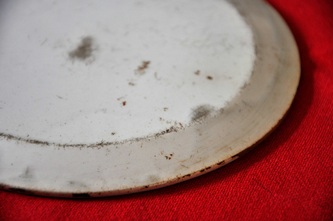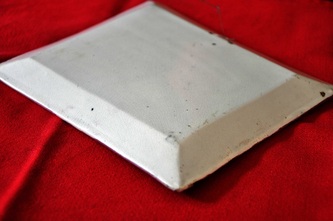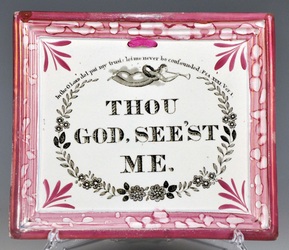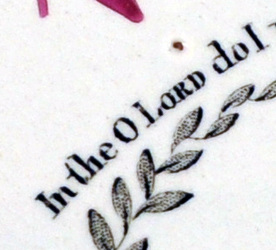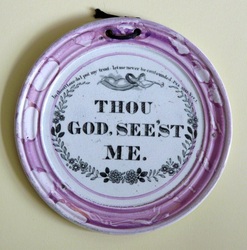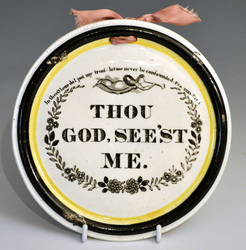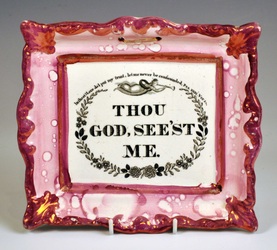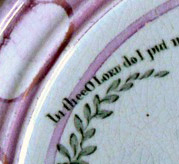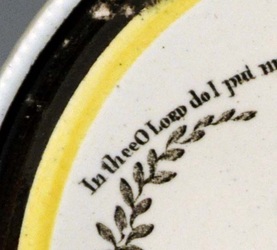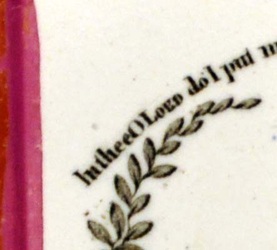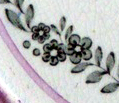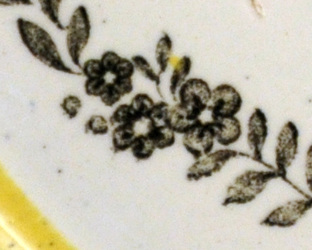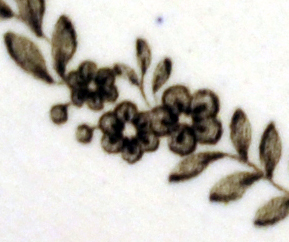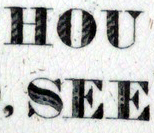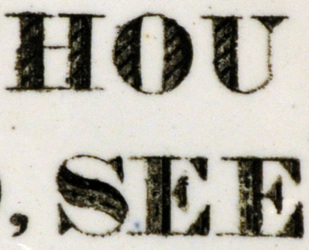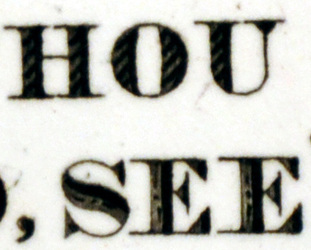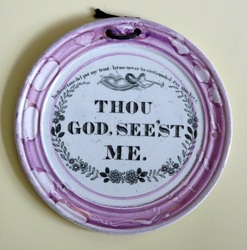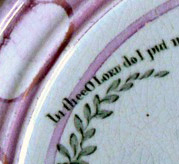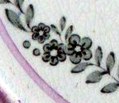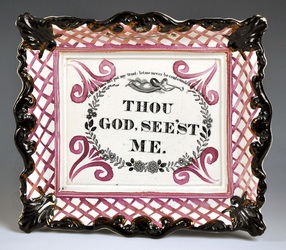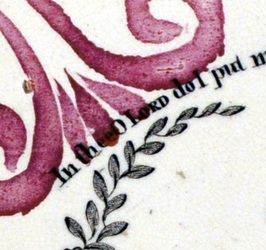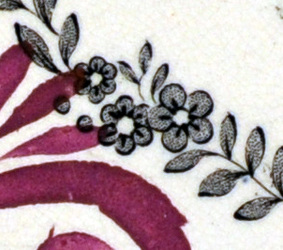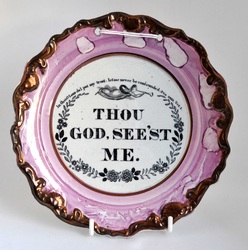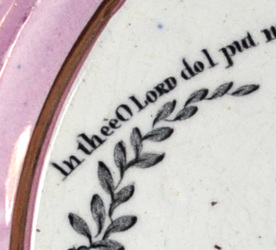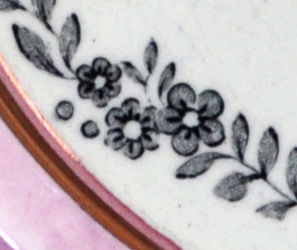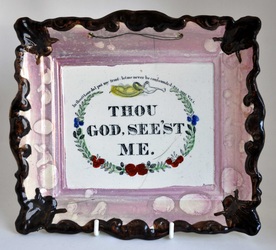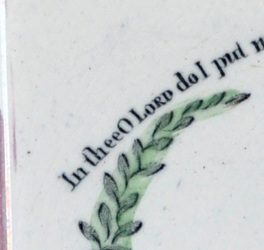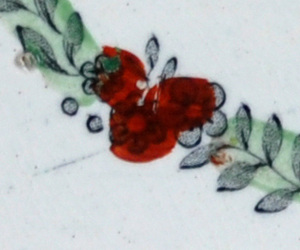|
4/28/2011 1 Comment A Dixon bowl with GaribaldiThanks to Ian Holmes for providing the three shots below left of a bowl with Garibaldi. The three transfers all appear on typical Garrison Pottery plaques marked Dixon Co. Do they help us in determining the date of the Garibaldi transfer? Was it made to commemorate his visit to Tyneside in 1854, or his visit to London in 1864? The 'Gauntlet Clipper Ship' transfer is copied from an engraving in the Illustrated London News published on April 27, 1853. Baker dates the 'New Bridge over the Wear at Sunderland' transfer as c1859. So all we really know is that the bowl must have been made after c1859.
I still think 1854 is the most likely date for Garibaldi, and that the transfer plate had been in use for five or six years when the bowl was made. What might settle it is an item with a Garibaldi transfer, and a hand-painted date pre 1864!
1 Comment
Today is St George's day – England's patron saint. It is also the birthday of my friend Pete (Happy Birthday Pete) and William Shakespeare. When I was in New York in January, a friend spoke over dinner of a Moore & Co plaque with a transfer of William Shakespeare. I'd never heard of a Shakespeare transfer on any item of Sunderland pottery. I tried to visualise what the image on the plaque might look like. Most likely, I thought, like this... But when the photos arrived, they smashed all my expectations. Shakespeare looks altogether more handsome. The transfer is nice and large, and beautifully titled. I love the way the lustre band on the bottom border curves round underneath the tunic to accommodate the image. Click on the pictures to enlarge. So when was this plaque produced? The obvious date is 1864 for the tricentenary of Shakespeare's birth (in 1564). Taking a look at the plaque dates page, we might have expected the plaque to be slightly earlier. But note that Moore & Co produced a similar plaque in 1859 for the centenary of Robert Burns' birth (see the portraits page). So it looks as if fine plaques of this form continued to be produced right into the 1860s. Thinking about the date of this plaque has made me question the date of another. On the dates page, I've suggested that the Garibaldi plaques below were made to commemorate his stay in Tyneside in 1854. Wikipedia writes that Garibaldi 'arrived on March 21, 1854. Garibaldi, already a popular figure on Tyneside, was welcomed enthusiastically by local workingmen, although the Newcastle Courant reported that he refused an invitation to dine with dignitaries in the city. He stayed in South Shields on Tyneside for over a month, departing at the end of April 1854. During his stay, he was presented with an inscribed sword'. All of that seems clear enough, so what's the problem? Take a look at the pair of Staffordshire figures below (taken from Castle Antiques website). Yes, they are a proper pair, made to celebrate Garibaldi's visit to London in 1864, which coincided with the tricentenary of Shakespeare's birth. Britain got quite carried away by the association. On April 24, 1864, David Maginnis gave a sermon in Stourbridge entitled 'Of Great Men: with special reference to Garibaldi and Shakespeare'. The sermon was subsequently published. I also found this print from the National Potrait Gallery Archive. The bard says, 'Come I say, old fellow, don't go and snuff me out, get it over before the 23rd.'
The hero replies, 'Ah! I wonder whether my countrymen will remember me three hundred years hence!' So do our Shakespeare and Garibaldi plaques form a pair? I'm afraid not. The Garibaldi plaques are stamped 'Dixon Co', and the Shakespeare plaque 'Moore & Co'. It's open to question whether the Dixon plaques could have been made to celebrate this later visit by Garibaldi to the UK. The Dixon (Garrison) pottery closed in 1865. If they were produced in 1864, that would have been within the pottery's dying breaths. My gut feeling is that the earlier date of 1854 is more likely. Of course, the Shakespeare plaque is so rare, there may be an equally rare Garibaldi, by Moore & Co, out there somewhere to pair. 4/6/2011 1 Comment Pass the potatoThe 'Flying Cloud Boston' and 'Agamemnon' reproductions are so well known, why do I keep on blogging about them? About four years ago, our friend Edmund the faker, sold a 'Flying Cloud Boston' on eBay as a 19th century original. I've described this as a 'double whammy', because not only is the plaque late 20th century, it's also covered in fake overpainting. The plaque resurfaced on eBay a couple of months ago (see left below), and I contacted the seller. He said he'd bought it on eBay a few years ago, from Edmund he thought, and promptly removed the listing. But unless you take a hammer to an object like this, it never really dies. So here it is again, like the proverbial bad penny, back on eBay, and listed as a 19th century original, along with an unpainted 'Agamemnon'. Of course the seller might have bought the items in good faith, and why should he/she be out of pocket? I contacted them a couple of days ago, and despite a polite assurance they'd look into it, both plaques are still listed as 19th century. Bizarrely, the plaque now has some value as an item of curiosity, being vintage 'Edmund' and produced at the nadir of his powers. Whatever the outcome of the eBay auction, I doubt it will be the last we see of it. P.S.Sold for £31.61. A high price for a piece of modern junk!
The eagle eyed amongst you might have noticed that a couple of days ago I upgraded my description of the left plaque below (on the Prepare to meet thy god page) from 'unidentified pottery, possibly Scott' to 'attributed to Scott'. I did this partly because of the discovery in my previous blog post, that its pair, the 'Thou God' on the right below, came from transfer plate 3, and not plate 2 as expected. (N.B. the plaque on the left comes from the plate 2 set, and the plaque on the right from the plate 3 set.) Scott is the common denominator between the two transfer sets. Had they both come from plate 2, there was a chance that they'd been made by an unidentified pottery, which later sold its plates to Scott (just as Newbottle appears to have done). If that is too mind bending, don't worry! There's another very simple reason I now believe these plaques to be Scott. It is very difficult to get an accurate feel for a plaque by looking at a photograph. Some circular plaques are heavily potted with an edge almost a centimetre thick. Others are very fine, and as a result much lighter. I met the owner of the plaques above for dinner on Friday, and was at last able to see them in the flesh. They share a common feature with the two Scott-attributed plaques below, which have the plate 1 transfer ('in the O Lord'). All of the plaques above have what I can only describe as a chamfered back. I've added the photos below to show what I mean. The plaque mould was in two pieces, allowing a finer shape, and minimising the amount of clay used. So compared to those with flat backs, these plaques are lighter. (Myrna tells me she has one of these small rectangular plaques with a rounded back, so there is at least one variation to the rear mould.) This provides another strong link between our Scott groups, with transfer plates 1, 2 & 3 being used on plaques apparently from the same mould. And of course, the Wesley and Clarke transfers attributed to 'Southwick', and the Charles Wesley verses, also appear on both these plaque forms.
In my February 21st blog post I took a detailed look at the 'Prepare' transfers associated with the Sunderland potteries, and threatened one day to do the same for the 'Thou Gods'. Before reading this blog post, please take another look at the Prepare to meet thy god page. I have identified four distinct 'Prepare' transfer plates, and labelled them 'plate 1' to 'plate 4'. In theory, there should be a corresponding 'Thou God' for each of the four 'Prepare' plates. It is easy to find the 'Thou God' pair for the plate 1 'Prepare', because instead of the verse at the top reading 'In thee O Lord...', it begins 'In the O Lord...' (see detail below). The obvious way to distinguish the transfers that correspond with the remaining plates (2–4), was to look at three plaques that had 'Prepare' counterparts in each of the groups. So, you'd expect the Scott-attributed plaque on the left below, to have a transfer that paired with 'Prepare' plate 2. You'd expect the centre Newbottle-attributed plaque to have a transfer that paired with plate 3. And you'd expect the plaque on the right below, which has a Moore & Co impressed mark, to have a transfer that paired with plate 4. What could be simpler? But as always, it's trickier than expected. The Moore & Co transfer (plate 4) is easy enough to distinguish because the small circles to the left of the flowers (see third detail) are joined to the sprig with stalks. Also, as before, the leaf under the 't' of 'thee' (see first details) is shaded on the left side on the Moore & Co plaque. So we have our plate 4. However, try as I might – I've given myself eyestrain comparing enlarged images on my computer screen – I can find no differences between the two circular plaques. Note the correspondence of the lines shading the letter 'u' in the last detail. I am as certain as I can be that they come from the same transfer plate. Given that the plate was in use at Newbottle 'High' Pottery before it came to Scott, it must correspond to plate 3. So where is plate 2's counterpart? I decided to compare all the Scott 'Thou Gods' for which I have high quality images. If plate 2 exists, you'd expect it to have the following attributes:
All of the plaques above look to have identical transfers that come from plate 3. So either a corresponding 'Thou God' transfer to plate 2 doesn't exist, or I've not found it yet.
There are 75 photographs of 'Prepare' plaques on the Prepare to meet thy god page. Whereas there are only 41 photographs of 'Thou God' plaques on the Thou god seest me page. Though by no means a scientific measure, it seems clear that considerably fewer 'Thou Gods' were ever made. If the verse was less popular that might explain why fewer transfer plates were made. As ever, please take a close look at your 'Thou Gods'. Perhaps you have one from the missing plate 2. |
AuthorStephen Smith lives in London, and is always happy to hear from other collectors. If you have an interesting collection of plaques, and are based in the UK, he will photograph them for you. Free advice given regarding selling and dispersal of a collection, or to those wishing to start one. Just get in touch... Archives
February 2022
AcknowledgementsThis website is indebted to collectors, dealers and enthusiasts who have shared their knowledge or photos. In particular: Ian Holmes, Stephen Duckworth, Dick Henrywood, Norman Lowe, Keith Lovell, Donald H Ryan, Harold Crowder, Jack and Joyce Cockerill, Myrna Schkolne, Elinor Penna, Ian Sharp, Shauna Gregg at the Sunderland Museum, Keith Bell, Martyn Edgell, and Liz Denton.
|
